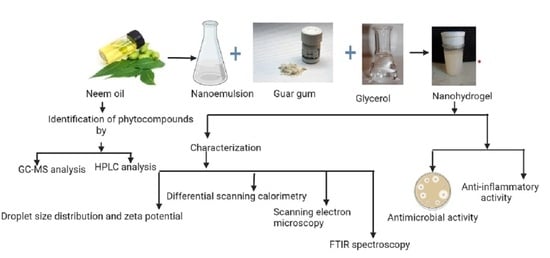Antimicrobial and Anti-Inflammatory Activity of Low-Energy Assisted Nanohydrogel of Azadirachta indica Oil
Abstract
:1. Introduction
2. Results and Discussion
2.1. Identification of Phytocompounds
2.2. Estimation of Phytocompounds by HPLC Analysis
2.3. Characterization of Nanohydrogel
2.3.1. Physiochemical Characteristics of Azadirachta indica Oil Nanohydrogels
2.3.2. Droplet Size Distribution and Zeta Potential of Hydrogels
2.3.3. Differential Scanning Calorimetry
2.3.4. Scanning Electron Microscopy
2.4. FTIR Spectroscopy of Nanohydrogels
2.5. In Vitro Antimicrobial Activity
Time–Kill Kinetics
2.6. Anti-Inflammatory Activity
3. Conclusions
4. Materials and Methods
4.1. Materials
4.1.1. Identification of Phytocompounds
GC–MS Analysis of Azadirachta indica Oil
HPLC Analysis of Azadirachta indica oil
4.2. Preparation of Azadirachta indica Oil Nanohydrogels
4.3. Characterization of Nanohydrogels
4.3.1. Droplet Size Distribution and Zeta Potential of Hydrogels
4.3.2. Differential Scanning Calorimetry
4.3.3. Field Emission Scanning Electron Microscopy (FESEM)
4.3.4. Fourier Transform Infrared (FTIR) Spectroscopy
4.4. Anti-Inflammatory Activity of Nanohydrogels
4.4.1. Antimicrobial Activity
In-Vitro Minimum Inhibitory Concentration (MIC), Minimum Fungicidal Concentration (MFC), and Minimum Bactericidal (MBC), of Nanohydrogels
Time–Killed Kinetics
4.5. Albumin Denaturation Assay
4.6. Statistical Analysis
Author Contributions
Funding
Data Availability Statement
Acknowledgments
Conflicts of Interest
References
- Banerjee, K.; Chatterjee, M.; Sandur, R.; Nachimuthu, R.; Madhyastha, H.; Thiagarajan, P. Azadirachta indica A. Juss (Neem) oil topical formulation with liquid crystals ensconcing depot water for anti-inflammatory, wound healing, and anti-methicillin resistant Staphylococcus aureus activities. JDDST 2021, 64, 102563. [Google Scholar] [CrossRef]
- Kumar, S.; Singh, N.; Devi, L.S.; Kumar, S.; Kamle, M.; Kumar, P.; Mukherjee, A. Neem oil and its nanoemulsion in sustainable food preservation and packaging: Current status and prospects. J. Agric. Food Res. 2022, 7, 100254. [Google Scholar] [CrossRef]
- Goyal, A.; Sharma, A.; Kaur, J.; Kumari, S.; Garg, M.; Sindhu, R.K.; Abdel-Daim, M.M. Bioactive-based cosmeceuticals: An update on emerging trends. Molecules 2022, 27, 828. [Google Scholar] [CrossRef] [PubMed]
- Demirak, M.Ş.Ş.; Canpolat, E. Plant-based bioinsecticides for mosquito control: Impact on insecticide resistance and disease transmission. Insects 2022, 13, 162. [Google Scholar] [CrossRef] [PubMed]
- Hassanein, H.; Salem, F.E.H.; Farag, M.A.; Ahmed, A.M. Sustainable hypoglycemic action of neem oil on male rabbits and its impact on some glucose regulating hormones. Egypt. Acad. J. Biol. Sci. C Physiol. Mol. Biol. 2021, 13, 189–209. [Google Scholar] [CrossRef]
- Manca, M.L.; Manconi, M.; Meloni, M.C.; Marongiu, F.; Allaw, M.; Usach, I.; Ghavam, M. Nanotechnology for natural medicine: Formulation of neem oil loaded phospholipid vesicles modified with argan oil as a strategy to protect the skin from oxidative stress and promote wound healing. Antioxidants 2021, 10, 670. [Google Scholar] [CrossRef]
- De Castro e Silva, P.; De Oliveira, A.C.; Pereira, L.A.; Valquíria, M.; Carvalho, G.R.; Miranda, K.W.; Oliveira, J.E. Development of bionanocomposites of pectin and nanoemulsions of carnauba wax and neem oil pectin/carnauba wax/neem oil composites. Polym. Compos. 2020, 41, 858–870. [Google Scholar] [CrossRef]
- Amra, K.; Momin, M.; Desai, N.; Khan, F. Therapeutic benefits of natural oils along with permeation enhancing activity. Int. J. Dermatol. 2022, 61, 484–507. [Google Scholar] [CrossRef]
- Islas, J.F.; Acosta, E.; Zuca, G.; Delgado-Gallegos, J.L.; Moreno-Treviño, M.G.; Escalante, B.; Moreno-Cuevas, J.E. An overview of neem (Azadirachta indica) and its potential impact on health. J. Funct. Foods 2020, 74, 104171. [Google Scholar] [CrossRef]
- Khan, M.R.; Huang, C.; Ullah, R.; Ullah, H.; Qazi, I.M.; Nawaz, T.; Ren, L. Effects of various polymeric films on the pericarp microstructure and storability of longan (cv. Shixia) Fruit treated with propyl disulfide essential oil from the neem (Azadirachta indica) Plant. Polymers 2022, 14, 536. [Google Scholar] [CrossRef]
- Kolap, R.M.; Kakade, P.S.; Gacche, R.N.; Zimare, S.B. Assessment of Radical Scavenging Activity and Estimation of EC50 Values of Various Extracts of Leaves and Roots from Lobelia nicotianifolia Roth. (Wild Tobacco). J. Herbs Spices Med. Plants 2021, 27, 343–364. [Google Scholar] [CrossRef]
- Raina, N.; Pahwa, R.; Bhattacharya, J.; Paul, A.K.; Nissapatorn, V.; De Lourdes Pereira, M.; Gupta, M. Drug Delivery Strategies and Biomedical Significance of Hydrogels: Translational Considerations. Pharmaceutics 2022, 14, 574. [Google Scholar] [CrossRef] [PubMed]
- Alfei, S.; Oliveri, P.; Malegori, C. Assessment of the Efficiency of a Nanospherical Gallic Acid Dendrimer for Long-Term Preservation of Essential Oils: An Integrated Chemometric-Assisted FTIR Study. ChemistrySelect 2019, 4, 8891–8901. [Google Scholar] [CrossRef]
- Prashar, S.; Sharma, S.; Kumar, N.; Kaushik, R.; Chawla, P. Formulation, characterization, and in vitro mineral absorption of Ficus Palmata fruit extract nanoemulsion. J. Am. Nutr. Assoc. 2022, 41, 291–300. [Google Scholar] [CrossRef] [PubMed]
- Li, X.M.; Meng, R.; Xu, B.C.; Zhang, B. Investigation of the fabrication, characterization, protective effect and digestive mechanism of a novel Pickering emulsion gels. Food Hydrocoll. 2021, 117, 106708. [Google Scholar] [CrossRef]
- Ghosh, C.; Sarkar, P.; Issa, R.; Haldar, J. Alternatives to conventional antibiotics in the era of antimicrobial resistance. Trends Microbiol. 2019, 27, 323–338. [Google Scholar] [CrossRef]
- Filippone, A.; Consoli, G.M.; Granata, G.; Casili, G.; Lanza, M.; Ardizzone, A.; Paterniti, I. Topical delivery of curcumin by choline-calix [4] arene-based nanohydrogel improves its therapeutic effect on a psoriasis mouse model. Int. J. Mol. Sci. 2020, 21, 5053. [Google Scholar] [CrossRef] [PubMed]
- Segaert, S.; Shear, N.H.; Chiricozzi, A.; Thaçi, D.; Carrascosa, J.M.; Young, H.; Descamps, V. Optimizing anti-inflammatory and immunomodulatory effects of corticosteroid and vitamin D analogue fixed-dose combination therapy. Dermatol. Ther. 2017, 7, 265–279. [Google Scholar] [CrossRef] [PubMed]
- Ramalakshmi, K.; Udaya Sankar, K. Characterization of neem (Azadirachta indica A. Juss) seed volatile compounds obtained by supercritical carbon dioxide process. J. Food Sci. Technol. 2018, 55, 1444–1454. [Google Scholar] [CrossRef]
- Adigwe, O.P.; Ibrahim, J.A.; Adamu, A.; Okhale, S.E.; Elias, A.; Egharevba, H.O. Chemometric Analysis of Volatile Compounds of NIPRINEEM Oil and Other Brands of Neem Seed Oils Sold in Nigeria. J. Biophys. Chem. 2022, 13, 1–12. [Google Scholar] [CrossRef]
- Gossé, B.; Amissa, A.A.; Anoh Adjé, F.; Bobélé Niamké, F.; Ollivier, D.; Ito, Y. Analysis of components of neem (Azadirachta indica) oil by diverse chromatographic techniques. J. Liq. Chromatogr. Relat. Technol. 2005, 28, 2225–2233. [Google Scholar] [CrossRef]
- Cesa, S.; Sisto, F.; Zengin, G.; Scaccabarozzi, D.; Kokolakis, A.K.; Scaltrito, M.M.; Basilico, N. Phytochemical analyses and pharmacological screening of Neem oil. S. Afr. J. Bot. 2019, 120, 331–337. [Google Scholar] [CrossRef]
- Altaf, F.; Niazi, M.B.K.; Jahan, Z.; Ahmad, T.; Akram, M.A.; Butt, M.S.; Sher, F. Synthesis and characterization of PVA/starch hydrogel membranes incorporating essential oils aimed to be used in wound dressing applications. J. Polym. Environ. 2021, 29, 156–174. [Google Scholar] [CrossRef]
- Rahiminezhad, Z.; Gahruie, H.H.; Esteghlal, S.; Mesbahi, G.R.; Golmakani, M.T.; Hosseini, S.M.H. Oxidative stability of linseed oil nano-emulsions filled in calcium alginate hydrogels. LWT 2020, 127, 109392. [Google Scholar] [CrossRef]
- Mishra, P.R.; Al Shaal, L.; Müller, R.H.; Keck, C.M. Production and characterization of Hesperetin nanosuspensions for dermal delivery. Int. J. Pharm. 2009, 371, 182–189. [Google Scholar] [CrossRef]
- Wu, L.; Zhang, J.; Watanabe, W. Physical and chemical stability of drug nanoparticles. Adv. Drug Deliv. Rev. 2011, 63, 456–469. [Google Scholar] [CrossRef]
- Wu, B.; Feng, J.; Zeng, T.; Guo, Q.; Zhang, Z.; Ding, C.; Sai, S. Flurbiprofen loaded thermosensitive nanohydrogel for ophthalmic anti-inflammatory therapy. J. Drug Deliv. Sci. Technol. 2022, 70, 103253. [Google Scholar] [CrossRef]
- Thakur, R.; Pristijono, P.; Golding, J.B.; Stathopoulos, C.E.; Scarlett, C.J.; Bowyer, M.; Vuong, Q.V. Amylose-lipid complex as a measure of variations in physical, mechanical and barrier attributes of rice starch-ι-carrageenan biodegradable edible film. Food Packag. Shelf Life 2017, 14, 108–115. [Google Scholar] [CrossRef] [Green Version]
- Altaf, S.; Ajaz, H.; Imran, M.; Ul-Hamid, A.; Naz, M.; Aqeel, M.; Ikram, M. Synthesis and characterization of binary selenides of transition metals to investigate its photocatalytic, antimicrobial and anticancer efficacy. Appl. Nanosci. 2020, 10, 2113–2127. [Google Scholar] [CrossRef]
- Abdel-Raouf, M.E.; El-Saeed, S.M.; Zaki, E.G.; Al-Sabagh, A.M. Green chemistry approach for preparation of hydrogels for agriculture applications through modification of natural polymers and investigating their swelling properties. Egypt. J. Pet. 2018, 27, 1345–1355. [Google Scholar] [CrossRef]
- Khan, M.; Shah, L.A.; Rehman, T.; Khan, A.; Iqbal, A.; Ullah, M.; Alam, S. Synthesis of physically cross-linked gum Arabic-based polymer hydrogels with enhanced mechanical, load bearing and shape memory behavior. Iran. Polym. J. 2020, 29, 351–360. [Google Scholar] [CrossRef]
- Quereshi, D.; Dhal, S.; Das, D.; Mohanty, B.; Anis, A.; Shaikh, H.; Pal, K. Neem seed oil and gum arabic-based oil-in-water emulsions as potential ocular drug delivery system. J. Dispers. Sci. Technol. 2020, 41, 1911–1924. [Google Scholar] [CrossRef]
- Najda, A.; Bains, A.; Chawla, P.; Kumar, A.; Balant, S.; Walasek-Janusz, M.; Kaushik, R. Assessment of Anti-Inflammatory and Antimicrobial Potential of Ethanolic Extract of Woodfordia fruticosa Flowers: GC-MS Analysis. Molecules 2021, 26, 7193. [Google Scholar] [CrossRef] [PubMed]
- Peng, N.; Zhang, X.; Xu, H.; Liu, Y. Polymeric hydrogels with antimicrobial activity—A review of their progress. J. Sci. Tech. Res. 2019, 23, 17810–17823. [Google Scholar] [CrossRef]
- Kaur, N.; Bains, A.; Kaushik, R.; Dhull, S.B.; Melinda, F.; Chawla, P. A review on antifungal efficiency of plant extracts entrenched polysaccharide-based nanohydrogels. Nutrients 2021, 13, 2055. [Google Scholar] [CrossRef] [PubMed]
- Yesmin, S.; Paul, A.; Naz, T.; Rahman, A.A.; Akhter, S.F.; Wahed, M.I.I.; Siddiqui, S.A. Membrane stabilization as a mechanism of the anti-inflammatory activity of ethanolic root extract of Choi (Piper chaba). Clin. Phytosci. 2020, 6, 76. [Google Scholar] [CrossRef]
- Bains, A.; Chawla, P. In vitro bioactivity, antimicrobial and anti-inflammatory efficacy of modified solvent evaporation assisted Trametes versicolor extract. 3 Biotech 2020, 10, 404. [Google Scholar] [CrossRef]
- Liu, Y.; Huang, Y.; Zhang, C.; Li, W.; Chen, C.; Zhang, Z.; Zhang, Y. Nano-FeS incorporated into stable lignin hydrogel: A novel strategy for cadmium removal from soil. Environ. Pollut. 2020, 264, 114739. [Google Scholar] [CrossRef]
- Pathania, R.; Najda, A.; Chawla, P.; Kaushik, R.; Khan, M.A. Low-energy assisted sodium alginate stabilized Phyllanthus niruri extract nanoemulsion: Characterization, in vitro antioxidant and antimicrobial application. Biotechnol. Rep. 2022, 33, e00711. [Google Scholar] [CrossRef]
- Clinical and Laboratory Standard Institute (CLSI). Performance Standards for Antimicrobial Susceptibility Testing; 20th Informational Supplement; CLSI document M100-S20; Clinical and Laboratory Standard Institute, CLSI: Wayne, PA, USA, 2010. [Google Scholar] [CrossRef]
- Kaushik, R.; Chawla, P.; Kumar, N.; Janghu, S.; Lohan, A. Effect of pre-milling treatments on wheat gluten extraction and noodle quality. Food Sci. Technol. Int. 2018, 24, 627–636. [Google Scholar] [CrossRef]

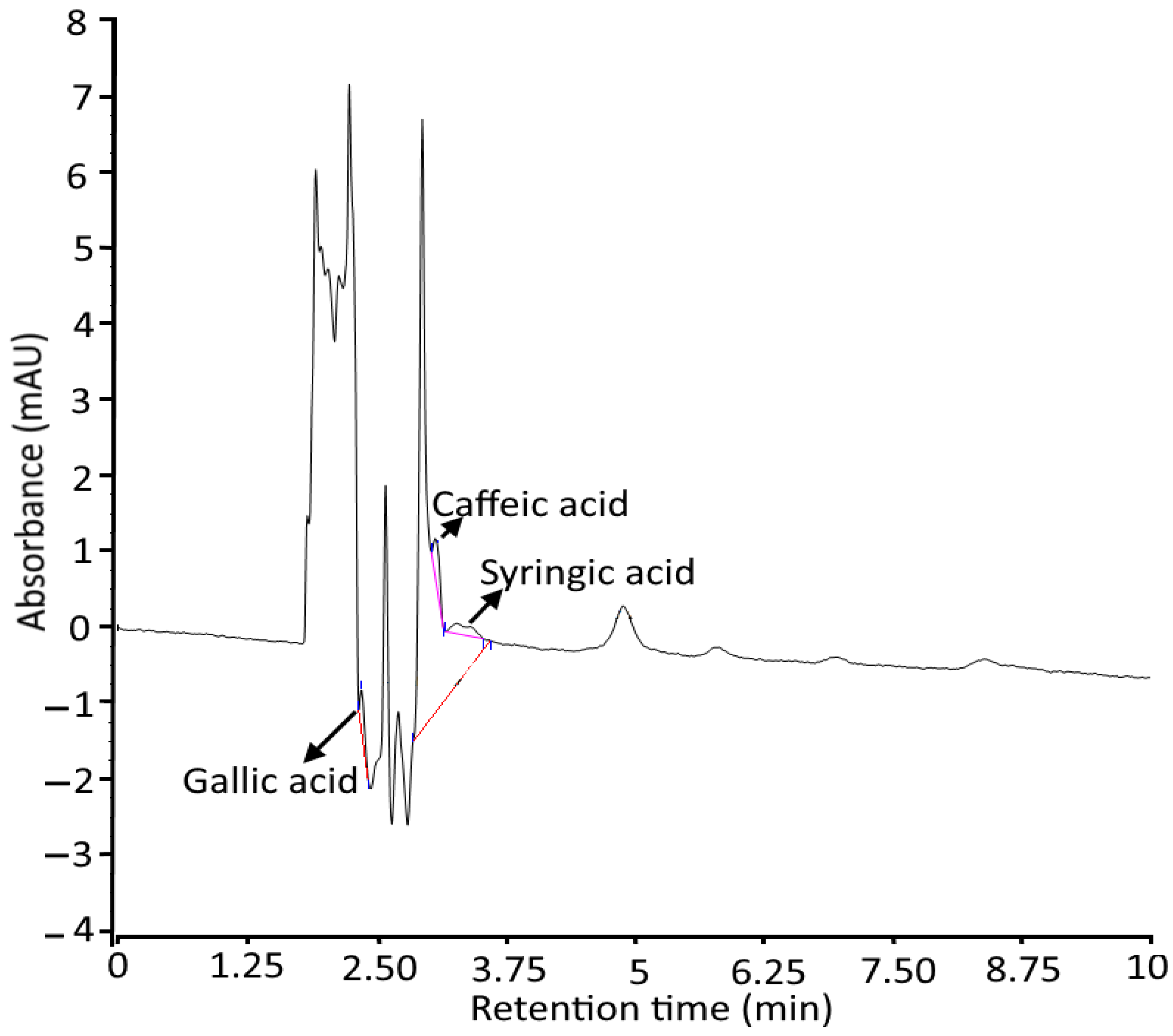

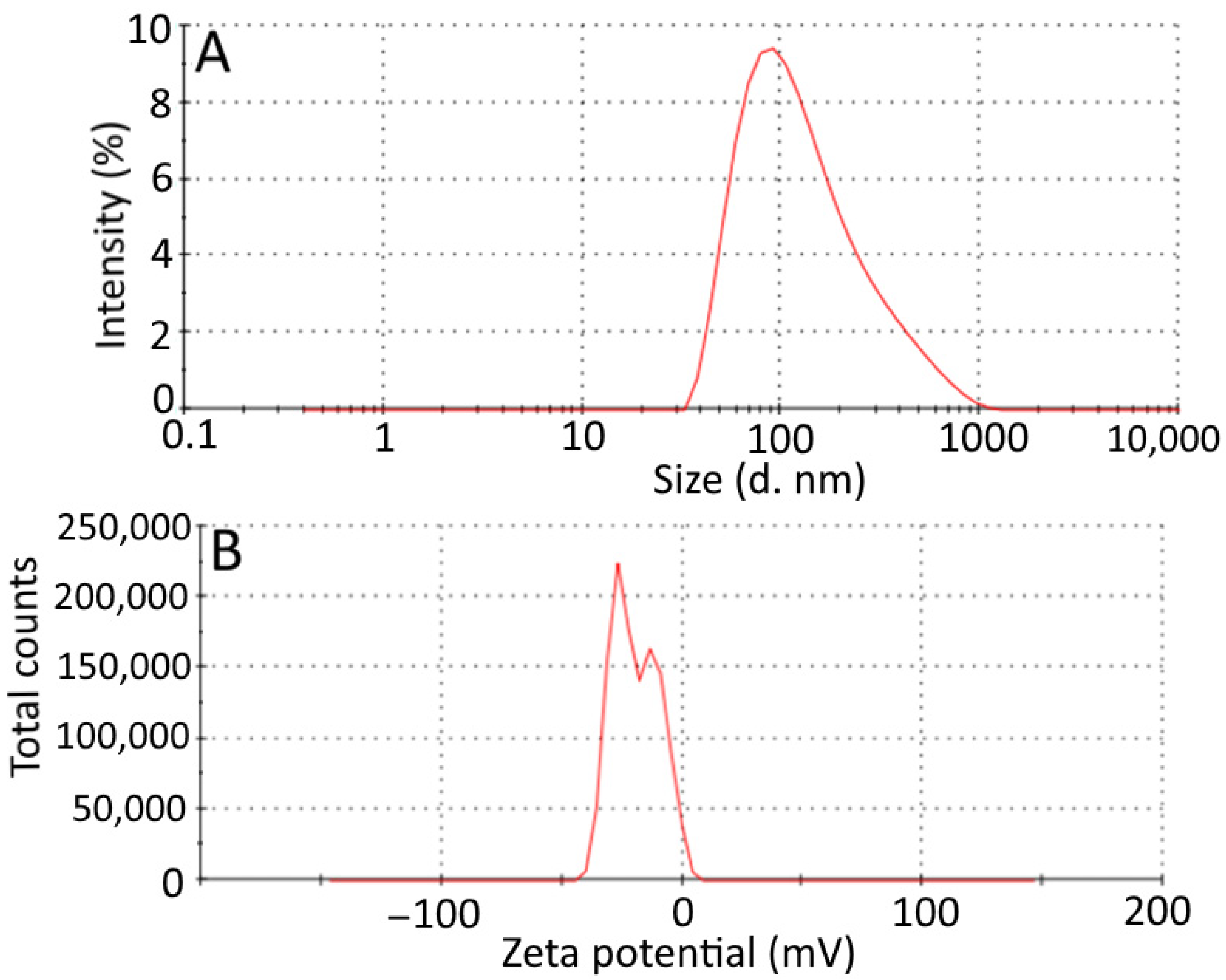
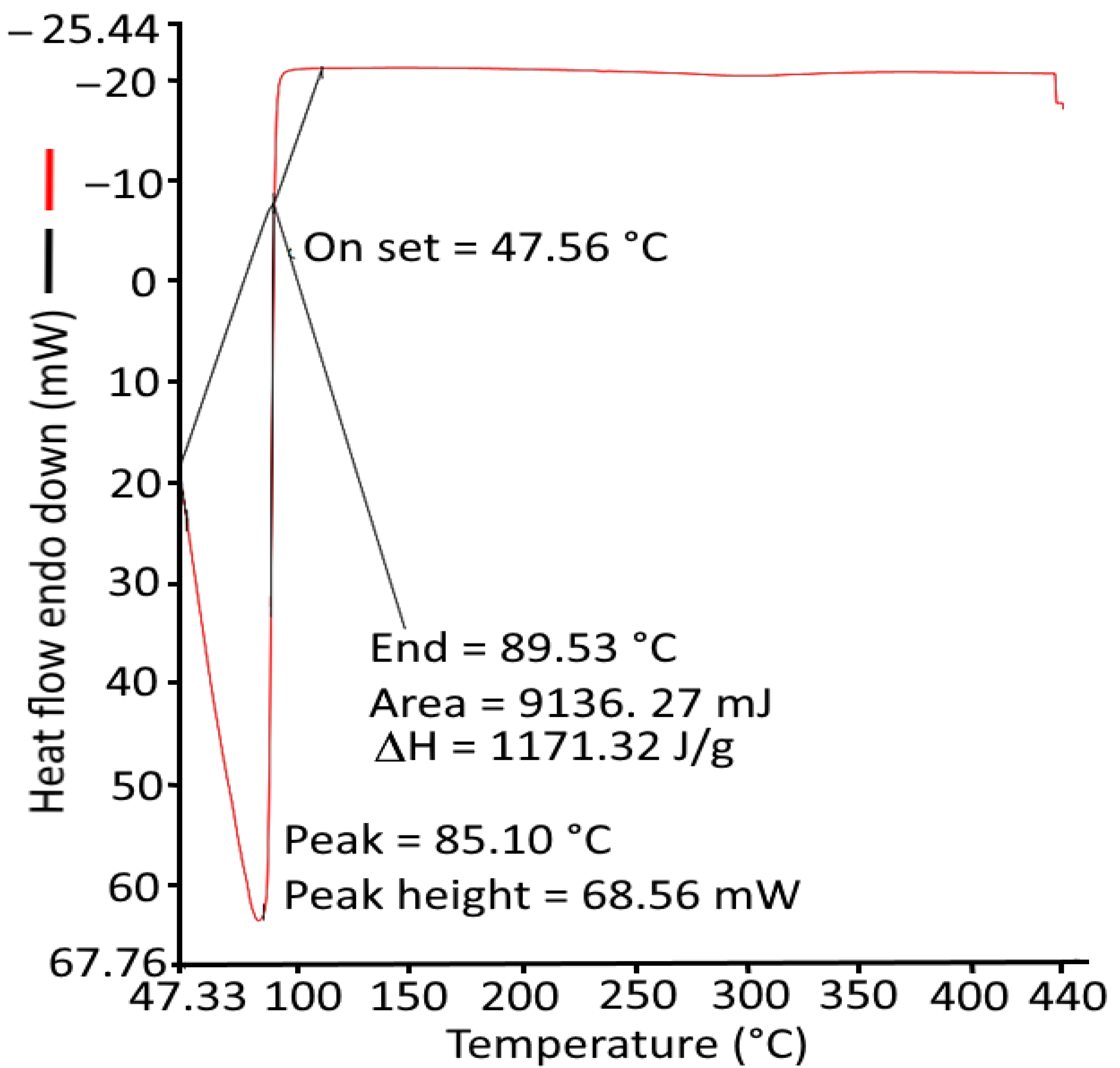
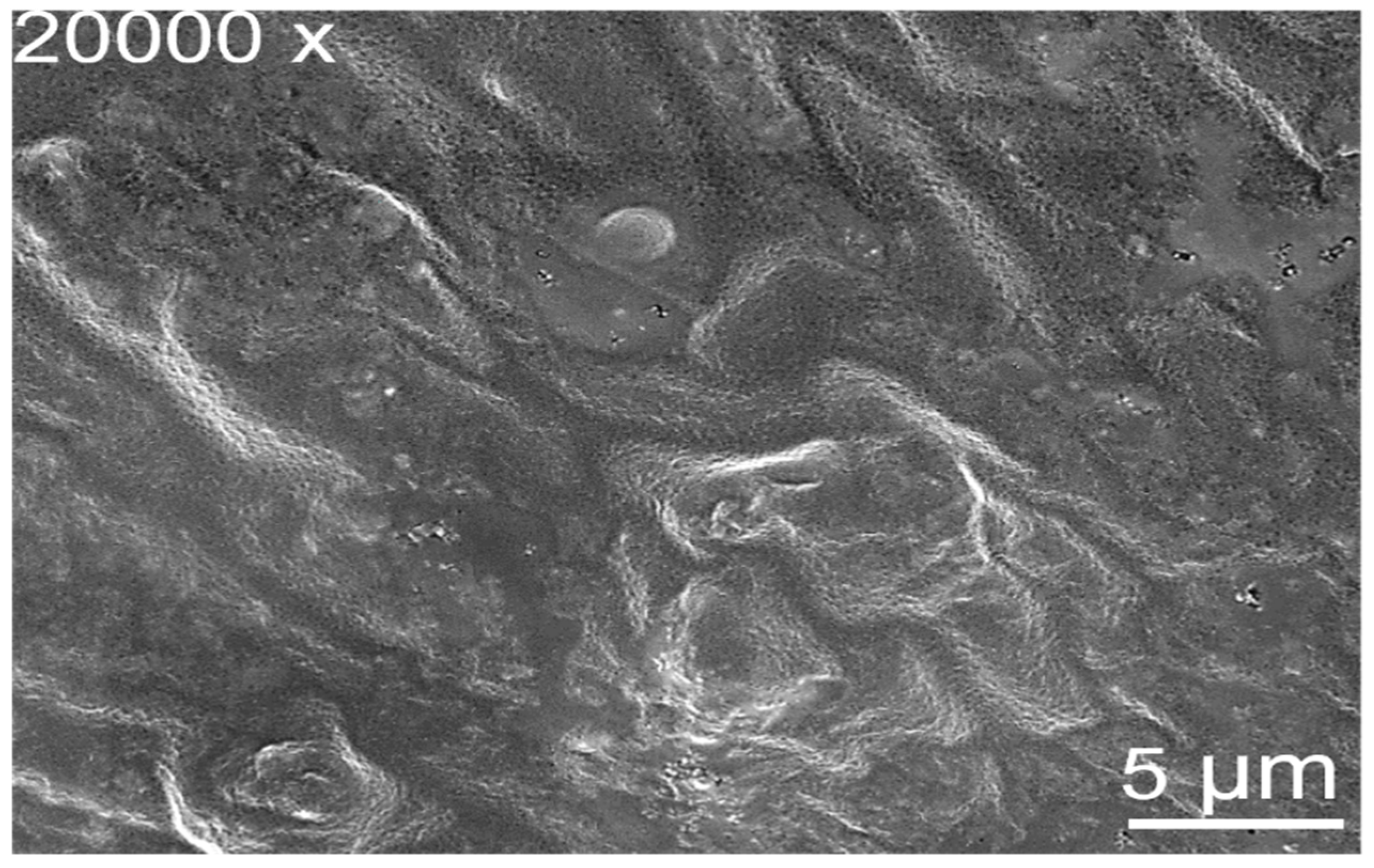


| Compound Isolated | Retention Time | Molecular Formula |
|---|---|---|
| Methyl-8-methyl-nonanoate | 13.63 | C11H22O2 |
| pentadecanoic acid | 21.54 | C16H32O2 |
| hexadecenoic acid | 23.03 | C17H34O2 |
| heptadecanoic acid | 24.57 | C18H36O2 |
| 9-octadecanoic acid (Z)-methyl ester | 26.08 | C19H36O2 |
| ç-Linolenic acid, methyl ester | 28.29 | C19H32O |
| eicosanoic acid, methyl ester | 28.77 | C21H42O2 |
| docosanoic acid, methyl ester | 31.21 | C23H46O2 |
| 8-Octadecane | ||
| 3-ethyl-5-(2 ethylbutyl) | 35.74 | C26H54 |
| Phyto Compound | Retention Time (min) | Quantity (mg/kg) |
|---|---|---|
| Gallic acid | 2.350 | 0.0076 |
| Caffeic acid | 3.087 | 0.077 |
| Syringic acid | 3.273 | 0.0129 |
| Microorganism | MIC mL v/v | MBC/MFC mL v/v | POSITIVE CONTROL (Streptomycin) MBC/MFC mL/v/v |
|---|---|---|---|
| S. aureus | 6.25 | 3.125 | 0.0061 |
| E. coli | 3.125 | 3.125 | 0.0061 |
| C. albicans | 6.25 | 6.25 | 0.012 |
| Time (h) | E. coli (Log CFU/mL) | S. aureus (Log CFU/mL) | Time (h) | C. albicans (Log CFU/mL) |
|---|---|---|---|---|
| 0 | 8.40 ± 0.32 a | 8.34 ± 0.28 a | 48 | 7.79 ± 0.32 d |
| 18 | 8.27 ± 0.22 b | 8.18 ± 0.36 a | 72 | 7.32 ± 0.46 c |
| 24 | 8.14 ± 0.19 b | 7.94 ± 0.52 a | 96 | 7.10 ± 0.21 b |
| 48 | 7.98 ± 0.28 b | 7.83 ± 0.50 a | 120 | 6.94 ± 0.44 a |
Publisher’s Note: MDPI stays neutral with regard to jurisdictional claims in published maps and institutional affiliations. |
© 2022 by the authors. Licensee MDPI, Basel, Switzerland. This article is an open access article distributed under the terms and conditions of the Creative Commons Attribution (CC BY) license (https://creativecommons.org/licenses/by/4.0/).
Share and Cite
Kaur, S.; Sharma, P.; Bains, A.; Chawla, P.; Sridhar, K.; Sharma, M.; Inbaraj, B.S. Antimicrobial and Anti-Inflammatory Activity of Low-Energy Assisted Nanohydrogel of Azadirachta indica Oil. Gels 2022, 8, 434. https://doi.org/10.3390/gels8070434
Kaur S, Sharma P, Bains A, Chawla P, Sridhar K, Sharma M, Inbaraj BS. Antimicrobial and Anti-Inflammatory Activity of Low-Energy Assisted Nanohydrogel of Azadirachta indica Oil. Gels. 2022; 8(7):434. https://doi.org/10.3390/gels8070434
Chicago/Turabian StyleKaur, Sukhdeep, Priyanka Sharma, Aarti Bains, Prince Chawla, Kandi Sridhar, Minaxi Sharma, and Baskaran Stephen Inbaraj. 2022. "Antimicrobial and Anti-Inflammatory Activity of Low-Energy Assisted Nanohydrogel of Azadirachta indica Oil" Gels 8, no. 7: 434. https://doi.org/10.3390/gels8070434






